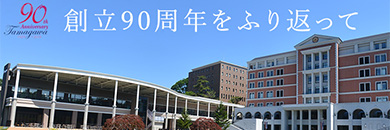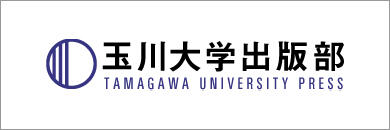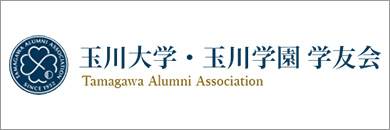STEM 最強のセキュリティ技術「量子エニグマ」
インフラへのサイバー攻撃を防御する最強の暗号技術
-量子エニグマの開発が始まる-
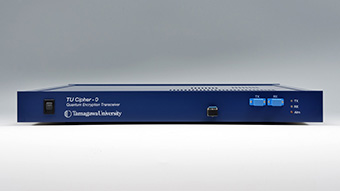
玉川大学では、世界に先駆けて量子情報及び量子通信の基礎理論を1980年代から研究し、2011年4月に量子情報科学研究所を開設しました。この研究所は量子情報科学の基礎研究を推進する「量子情報科学研究センター」と、量子情報理論の成果から導き出された新原理や新手法を社会で有益な技術に発展させる研究開発を行う「超高速量子通信研究センター」を設置しています。玉川大学は量子情報科学分野の研究者を育成する原点ともいえる世界最大の“量子通信国際会議”の創設にも携わり、世界では“この分野のファウンダー(創立者)”と言われています。
ここから巨視的量子効果を用いた新量子暗号であるY-00光通信量子暗号が発明され、サイバー攻撃に対処する最強の切り札として近未来に実用化が期待されています。昨年には100ギガビット毎秒という超高速にデータを暗号化して通信する実験に成功し、現在、国内外の企業等と共同開発を目指しています。
この究極的な技術を暗号の王様(King of Cryptography)の称号である“量子エニグマ”と呼び、標準化を目指した研究開発も行っております。
インフラに対するサイバー攻撃
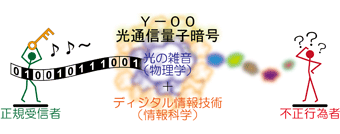
現代社会の基盤である電力、金融、交通システムなどの制御は高速光通信インフラによって支えられています。このような通信インフラはデータセンターを基盤とする次世代型インターネットの形態(クラウド・コンピューテイング・システム)で運用されます。
近年、この通信インフラに対するサイバー攻撃が深刻になってきました。しかし、国内で議論されているサイバー攻撃の分類と対策は十分ではありません。現在のサイバー攻撃はサーバーに侵入するソフト的な攻撃であり、多くの場合、データセンター化に際してのファイヤーウォール技術によって効果的な対策が可能です。
しかし、最も深刻な攻撃は、国内の通信業者が触れたくない通信回線への攻撃と言われています。この事案の発生の頻度は小さいですが、データセンターが丸ごとコピーされるため、一度、この事案が発生すれば、通信業者や利用者は壊滅的な被害を受けることが予想されています。そのため、通信回線を守る究極の暗号技術が必要不可欠なのです。このような考え方は、1998年に米国国防総省の国防高等研究計画局(DARPA)において、次世代インターネットの形態を、データセンターを基盤とする現在のクラウド方式に移行させる方策が立てられ、その際の基幹技術としてデータセンター間の高速通信回線を守る新技術の開発が企画された時から、すでに存在していました。そして、長い基礎研究期間を経て、近年、玉川大学とノースウエスタン大学において、その基盤技術が完成の域に達しました。DARPA は詳細仕様を公開し、実用機の開発を求めています。現在、この要請に応える事が出来る暗号は玉川大学で開発されたY-00光通信量子暗号以外には存在しないため、その実用化が期待されています。
本研究所は、これまでの技術を体系化し、まずは民生用として実用化を目指し、同時にこの暗号の理想系としての量子エニグマの開発を実施しております。
量子エニグマとは?
エニグマ(謎)暗号は旧ドイツ軍の最強の暗号で、その時代の最高水準の暗号理論を基盤として設計されました。当時の暗号は通信文であるアルファベットを不規則に並べ替えることによって暗号文を作成するものでした。その不規則性には周期があり、それが短いと全数探索で解読が可能になります。したがって、その周期をいかに長くするかが課題であり、エニグマは当時としては最長の周期を誇っていました。現代では、極めて長い周期を持つ擬似乱数を数学的に容易に設計することが可能です。しかし、エニグマは暗号学史に刻まれる暗号であり、暗号の研究者には普遍的な価値があります。
Y-00光通信量子暗号では、通信文を暗号用の数学によって設計された通信装置で暗号化します。さらに、その暗号文が物理現象である量子雑音によって隠されます(物理的暗号化)。その暗号文が量子雑音によって完全に隠されたとき、暗号文ですら復元することが不可能となります。一方で、正規の受信者は通信文を正しく復号できます。まさに“謎”の暗号なのです。 暗号文を完全に隠す技術には、まだまだ開発すべき課題が残っていますが、本研究所の研究者が一丸となって夢の量子エニグマの実現に挑戦しています。
Tamagawa University Quantum ICT Research Institute
Ultimate cryptography to safeguard infrastructures from cyber attack
- Development begins on the Quantum Enigma -
In the 1980s, Tamagawa University became among the world’s first in launching research on the fundamental theories of quantum information and quantum communication. In April 2011, Tamagawa University established the Quantum ICT Research Institute. The Institute comprises the Quantum Information Science Research Center, which pursues basic research on quantum information science, and the Quantum Communication Research Center involved in research and development to achieve socially beneficial technologies based on new theories derived by research on quantum information theory. Tamagawa University also organized the International Conference on Quantum Communication, Measurement and Computing, the world’s largest conference and said to have been the initial driving force behind the development of researchers in the field of quantum information science. In recognition of this achievement, Tamagawa University is referred to as the founder of the field of quantum information science.
The Quantum ICT Research Institute has developed so called Quantum Enigma powered by Yuen-2000 protocol which is a new quantum cryptography that relies on macroscopic quantum effects. When this cryptography finds practical applications in the near future, it is expected to become the most powerful defense against cyber attack. Researchers of the Institute experimentally demonstrated encrypted data communication at ultra-high speeds of 100 gigabits per second. The Institute is currently engaged in joint development efforts with companies and other organizations inside and outside Japan.
Referring to this ultimate encryption technology as the “Quantum Enigma,” an honorable designation granted to the King of Cryptography, the Institute will begin research and development on standardization efforts starting this year.
Cyber attacks on the infrastructure
A high-speed optical communications as infrastructure is essential to the control of the power supply, finance, transportation systems, etc. that undergird our modern society. The communications infrastructure is generally implemented using next-generation data centers linked over the Internet (cloud computing systems).
The rise of cyber attacks on these communication infrastructures in recent years has generated serious concerns. Currently in Japan, cyber attacks are not adequately identified and countermeasures tend to be inadequate. Since the current cyber attacks are based on software that attacks servers, it is possible to block cyber attacks on data centers through firewall technology.
The most serious threats are attacks on communication lines, and in general telecommunications carriers would rather hide this fact in public. Although such attacks are infrequent, attacks of this type can cause devastating damage to telecommunications carriers and to users, since the attacks allow copying of all data stored by data centers. Cryptographic technology of ultimate strength is required to protect against such attacks. The first signals of the need for such cryptography emerged in 1998, when the Defense Advanced Research Projects Agency (DARPA) under the United States Department of Defense established an initiative for a next-generation Internet currently so called cloud computing with data centers, along with plans to develop new and fundamental technologies for protecting the high-speed communication lines linking the data centers. After many years of basic research, Tamagawa University and Northwestern University completed development work the necessary foundational technologies. DARPA disclosed detailed specifications intended to promote the development of a practical engine. The Quantum Cryptography system powered by Y-00 protocol developed by Tamagawa University is the only current system capable of meeting DARPA’s requirements. Expectations for practical applications are quite high.
The Quantum ICT Research Institute is systematically reorganizing conventional technologies to achieve commercial cryptography applications. At the same time, the Institute is makin efforts to develop the Quantum Enigma as an ideal form of quantum cryptography based on Y-00 protocol.
What is the Quantum Enigma?
The Enigma (“enigma” for “mystery”) was the name of the most sophisticated encryption device developed by the German army during the war, based on the state-of-the-art cryptographic knowledge of the time. In those years, encryption meant the rearrangement of the letters in the original message into repeating irregular patterns. If the sequence period was short, the encrypted message could be deciphered through an exhaustive search for the encryption pattern. This made creating long period of sequences the key to ensuring high security. The Enigma encryption used by the German army during the war boasted the longest period at that time.
It’s now easy to design a long period of pseudorandom number sequence. Nonetheless, the technology associated with the Enigma encryption and code breaking represents a cornerstone of cryptography and a new chapter in the history of cryptographic techniques, one of universal interest to cryptography researchers.
Quantum Cryptography powered by Y-00 protocol consists of a communication device designed by mathematical encryption algorithm and multi-level optical modulator to encrypt the optical signals. The encrypted optical signals are also concealed by quantum noise when eavesdropper tries to receive such encrypted optical signals. Once the encrypted optical signals are completely hidden by quantum noise, even the original encrypted signals cannot be reproduced. The authorized receiver can decipher the encrypted optical signals without the disturbance of quantum noise? making it a mysterious form of cryptography indeed. Thus our new technology is profitable to call as “Quantum Enigma”.
Many technical issues remain to be resolved to develop a technology that can completely conceal encrypted optical signals. Through concerted joint efforts, the researchers at the Quantum ICT Research Institute are tackling various challenges to achieve an ideal quantum enigma.
